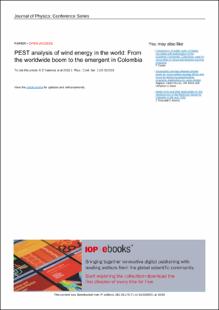PEST analysis of wind energy in the world: From the worldwide boom to the emergent in Colombia
Artículo de revista
2018-12-07
Journal of Physics: Conference Series
Estados Unidos
This article presents the analysis of the political, economic, social and technological aspects of the countries with the greatest development and generation of wind energy in the world, with the aim of studying the successes and disadvantages over the years and serve as a reference to a country like Colombia, which is in full technological development and is very interested in investing in new alternatives to the imminent ecological disaster resulting from polluting emissions. Colombia signs the Paris Agreement and immediately creates a large number of opportunities supported by state policies and economic investment, specifically in the construction of wind farms that guarantee a real alternative to the country's energy demand. Wind energy supplies 5% of the world's electricity, a contribution in which countries such as the United States, China, and Germany are the main producers. For this reason, it is necessary to study and analyze the factors that prevent the technological development of wind energy in Colombia, if it is considered a country with abundant resources in renewable energy sources and zero cost, a country that aspires to be a protagonist in the next 5 years according to the Ministry of Mines and Energy.
Descripción:
PEST analysis of wind energy in the world. From the worldwide boom to the emergent in Colombia.pdf
Título: PEST analysis of wind energy in the world. From the worldwide boom to the emergent in Colombia.pdf
Tamaño: 741.5Kb
 PDF
PDF
 LEER EN FLIP
LEER EN FLIP
Título: PEST analysis of wind energy in the world. From the worldwide boom to the emergent in Colombia.pdf
Tamaño: 741.5Kb
 PDF
PDF
 LEER EN FLIP
LEER EN FLIP















